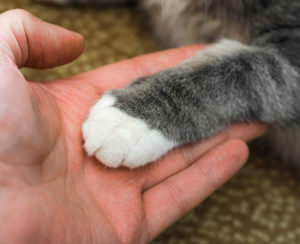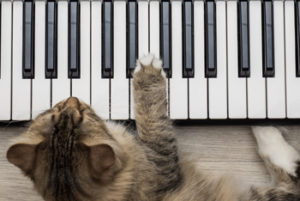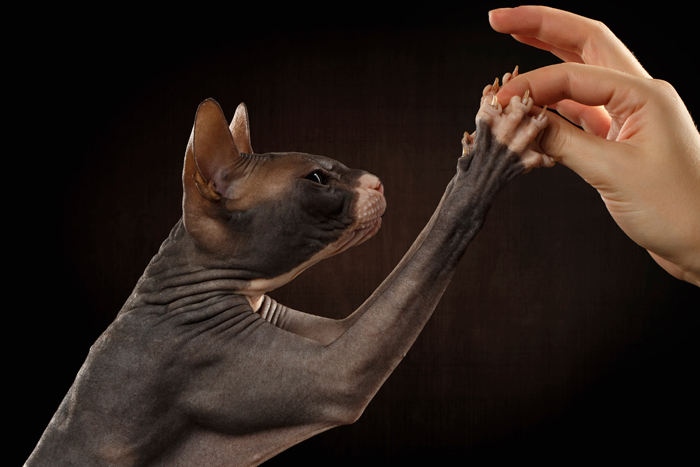Yes, you can train your feline.

Photo credit: Seregraff/iStock
Trick training a cat? Yeah right! Actually, with positive reinforcement clicker training, it can be very easy to train a cat to perform fun and amusing tricks.
Felines are also very fast learners and in a matter of days you can have your kitty giving you a high-five greeting and a feline rendition of Three Blind Mice on the piano.
How Clicker Training Works
Clicker training is a marker-based training method in which a trainer uses a handheld clicker to “click” and tell an animal that it’s done the right thing and instantly offer a reward.
The “click” identifies the behavior you plan to pay for the instant it is happening. You’re telling your cat, ”That’s it! I’ll pay you for exactly that!” The method reinforces what they instinctively do when they hunt for food and focuses on their natural tendencies to explore, experiment and play.
What you need:
- A clicker: available at pet supermarkets and online stores. If you cat is deaf, you can use a flashlight to identify the action you plan to reward.
- Treats: Choose something your cat really considers a treat, such as diced chicken, cheese or tuna—whatever you choose, it should be easily and quickly consumable. You will need about half a teaspoon for the average training session. Keep the pieces pea-sized. When paying your cat with the treat, place it on a saucer or small plate to keep upholstery and carpeting clean. If you are worried about weight gain, you could substitute 10 to 20 per cent of your cat’s regular meals with treats during training. Be sure to schedule training sessions before meal times.
- Targets: A target can be any stick-like object such as a pencil, chopstick or a wooden spoon. Later you can substitute a favorite toy such as a feathered object on a stick.
Getting Started: Shaping and Capturing Behaviors

Photo credit: MihailUlianikov/iStock
Start by teaching your cat to touch a target with her nose. Present the target by holding one end and put the other end near the cat’s face. It’s inevitable that the cat will touch it by sniffing it. As the cat’s nose is coming close to the target, capture the behavior by clicking and immediately give a treat. Remember every time you click, you must treat.
Initially your cat will not understand that these tasty tidbits are not random events but that you are shaping a behavior.
Target, click, treat—and repeat.
A total of five clicks and treats is a big training session for a cat who’s new to the idea. So keep training sessions short. Your cat will learn faster this way.
The Next Step: Teaching Cues
Once your cat has learned several behaviors, the next step is to teach her to do it on command by responding to a signal.
Cats relate better to gestures and hand signals than they do to verbal cues. Whether you are using your voice or a certain rap on a hard surface or hand gesture, use the same cue all the time and only use it once. The cat must learn to respond immediately.
Party Tricks
If you want to get friends and family to marvel at your cat’s skills, here are two tricks that are guaranteed to make your feline the center of attention at any party.
Kitty High Five

Photo credit: vertraut/iStock
First, train her to sit. Wait until she does it of her own accord and then capture it by clicking and treating.
Make sure she can repeat this in any room in the house and then establish a cue so that she will learn to do it on command. It can be the word “sit” or a hand gesture.
To teach the high-five slap, wiggle your fingers and move your hand in front of your cat’s paw on the ground. The moment the cat pats your fingers with her paw, click and treat.
When she consistently pats your moving fingers, slowly raise your hand off the ground until it’s up in the air and aligned with the cat’s shoulder height.
When your cat raises her paw, put your hand in the path of the movement and click the instant the paw touches your hand.
Next, move your hand slightly so that your cat has to aim for your hand with her paw to get a click.
Finally add the cue “Gimme Five” when you hold out your hand. Click and treat. You can also train her to stand up on her hind legs and give you a kitty high five.
Playing Three Blind Mice on the Piano

Photo credit: Anton Papulov/iStock
Day One: Prepare about 20 small treats and place them on an empty plate on the piano bench. Lure the cat to the seat, click as she jumps up and put a treat on the plate. If she stays on the bench keep clicking and treating.
Next, hold a treat over the keyboard. Click any movement toward and keyboard and any paw touch on the keys. Put the treat on the plate so that your cat must come down to eat and get back up to the keys to get a click.
Now, wait for the cat to move toward the keys or step on them without any help from you. Click any attempt, even if she just looks at the keys. When your cat is stepping or pawing on the keys with confidence, click for strong paw pats only. Click any audible plinks and reward with extra food.
Day Two: Repeat all the Day One’s steps. When your cat can make audible plinks on a regular basis, click and treat every second paw touch to build repeated sounds.
Put small removable stickers or post-it notes on the piano keys Middle C, D and E. Click only when the cat touches those keys.When the cat is hitting the notes E D C in that order, she is playing Three Blind Mice.
Consider buying her a toy piano and she can be the star of her own show.
About the Author: Sandy Robins is the 2013 winner of the “Excellence in Journalism and Outstanding Contribution to the Pet Industry Award.” Her work appears on many of the country’s leading pet platforms, such as MSNBC.com, MSN.com and TODAYShow.com. She is a regular contributor and columnist in multiple national and international publications, including Catster, as well as the author of the award-winning books “Fabulous Felines: Health and Beauty Secrets for the Pampered Cat” and “For The Love of Cats.” Learn more about Sandy on her website or Facebook page. #welovecats





